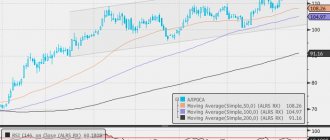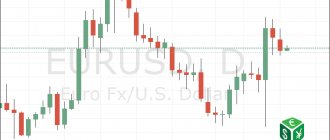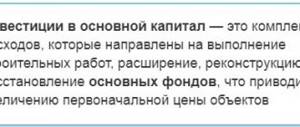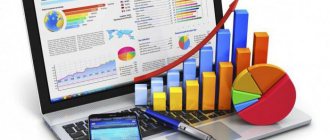What is PMI index
The PMI index refers to leading economic indices (indicators), which are also called survey ones. It is anticipatory because its meaning shows how the situation will (or may) develop in the future.
The indicator is formed based on a survey of purchasing managers of large companies. The questions they are asked relate to the number of orders, employment components, production volume, prices of exports and imports, and the amount of inventory in warehouses. Managers are also asked to rate whether their business situation has improved, worsened, or remained the same. Based on the responses received, the final value of the indicator is formed.
The scale of changes in PMI index values is from zero to 100. However, it has a “watershed” level - the level of 50. If the index is above this value, the economy continues to grow. A PMI below 50 indicates a contraction in the economy. Perhaps this is the main thing you need to know in order to assess the PMI level and draw a conclusion about the state of the economy now.
The PMI is measured in two sectors of the economy. The first shows how things are in the production sector, and the second - in economic sectors and types of activities that offer services to ensure the livelihoods of the population.
The exchange rate is more influenced by the PMI that corresponds to the dominant sector of the economy. For China and Germany, the manufacturing PMI is more important, since the manufacturing sector dominates the GDP. But for the United States, where GDP is formed mainly by the consumption sector, PMI in the services sector has a greater influence on the exchange rate.
Important to remember:
- PMI is typically published on the first business day of the month following the reporting period.
- The values are used to forecast GDP, employment levels, production growth rates, and orders for goods.
- If the PMI is in the region of 44%, then there is a high probability that the GDP growth rate will be zero.
- On average, PMI predicts a decline in the economy 2–3 months in advance.
Types of PMI index and by whom are they calculated?
The PMI index is calculated by different organizations.
ISM PMI - calculated by the Institute for Supply Management (ISM) since 1931. ISM is a non-profit professional organization whose members are managers of companies that are members of the association. ISM reports are divided into:
- industrial PMI (Manufacturing PMI);
- Non-production PMI (Services PMI).
They can be designated as ISM Manufacturing Index and Non-Manufacturing Business Activity Index, respectively. The report is published monthly, on the first working day, and is available on the website:
ismworld.org/supply-management-news-and-reports/reports/ism-report-on-business
The reports look like this:
IHS Markit produces its PMI reports for more than 40 countries, which are calculated similarly to the ISM. They are more popular in the Eurozone countries and China. IHS Markit indicators have the same division into manufacturing and non-manufacturing sectors, as well as a composite PMI index calculated on the basis of the industrial index and the service sector index. Information with company reports on the PMI index by country is available on the website:
markiteconomics.com/Public/Home/
In the “Latest PMI releases” section you can see the latest reports; in the “PMI calendar” block you can track the release of upcoming data.
Rosstat releases its analogue of PMI - the Entrepreneurial Confidence Index.
PMI dynamics and its impact on the exchange rate
As you know, the market moves under the influence of expectations. Therefore, when most important macroeconomic indicators are released, a local surge in volatility occurs if the actual value does not coincide with the forecast.
When we consider the PMI index (what it is) and its boundary separating the dynamics of growth from decline, what is important is which side of the level of 50 its indicators are located.
For example, before the start of the trade war between the United States and China and before the coronavirus crisis, PMI values for the main developed countries were well above the level of 50. In this case, small deviations from the predicted figures had almost no effect on exchange rates.
However, the approach of PMI to 50 and the transition through this “watershed” were already perceived by the market more sensitively, as it became clear that the economy had moved from growth to contraction.
It is worth noting that the slowdown in the economies of China and Germany due to the trade war was first shown by PMI indices in the industrial sector. These were the first clear warning signs, even before GDP figures reflected the slowdown. The resumption of business activity after the easing of quarantine measures due to the pandemic also became clear from the growth of PMI indices.
Below we will look at the most interesting PMI indices: China, Germany, Italy and the USA.
Latest US Manufacturing Business Activity (Index Points)
What is the growth in activity in the US manufacturing sector?
- The manufacturing business activity index in the US fell to 58.6 index. p. in February 2021. The maximum level reached 59.2 ind. p., and the minimum is 36.1 ind. P.
- Data published monthly by Markit Economics.
| 58.6 | Feb. 2021 | 19.02.2021 |
| 59.2 | Jan. 2021 | 22.01.2021 |
| 57.1 | Dec. 2020 | 16.12.2020 |
| 56.7 | but I. 2020 | 23.11.2020 |
| 53.4 | Oct. 2020 | 23.10.2020 |
| 53.2 | Sep. 2020 | 23.09.2020 |
| 53.1 | Aug. 2020 | 21.08.2020 |
| 50.9 | Jul. 2020 | 24.07.2020 |
PMI index in the economies of different countries: data analysis
China PMI Indices. China is known to be the world's largest manufacturing economy. The slowdown in the country's industry suggests that GDP growth rates will suffer significantly.
When the US launched a trade war against China in the second half of 2021, it hit the manufacturing sector. The tariffs meant that it became less profitable for China to produce goods for export to the United States. The PMI index (China) in manufacturing showed a decline: in November 2021 it reached the level of 50, in December it was already 49.40.
Further monthly: January 2021 - 49.50, February - 49.20. China's manufacturing PMI has been below 50 for most of 2021 as trade relations between the US and China have been tense.
At the end of 2021, China faced a new blow - the coronavirus outbreak. A strict lockdown was imposed at the start of 2021, the economy was shut down and the manufacturing PMI fell to 37.50 in February. However, China was the first to cope with the wave of COVID-19, and already in June the industrial PMI value reached 50.90, which, as you now know, indicates the transition of this sector of the economy to growth.
German Manufacturing PMI Index. The German economy is also characterized by a large share of the manufacturing sector. Moreover, the German economy, in particular its manufacturing sector, is the “locomotive” of the entire eurozone economy.
The trade war between the US and China has disrupted supply chains, which in turn has impacted German industry. Back in November 2021, the German manufacturing PMI was at 51.80, but in May 2021 it was only 44.30! (44.30 is well below 50, indicating that the industry has been seriously affected).
Meanwhile, the European Central Bank was discussing monetary measures, such as the possibility of launching a quantitative easing program, which could save the economy from the crisis.
The coronavirus pandemic has also led to another slowdown in Germany's manufacturing sector. In April, the PMI reached 34.40. And this indicates a significant decline.
Italian Services PMI Index. Despite the fact that the Italian economy is not as influential in the eurozone as the German one, the PMI in the services sector of this country clearly demonstrates how the value of the index changes during a crisis. Italy is known to have been hit hardest by the coronavirus pandemic. And since the service sector in the country prevails over manufacturing, PMI in the non-manufacturing sector will be the most significant indicator.
Thus, PMI in the Italian service sector before the pandemic was at the level of 51–52, and in February fell to 17.40 (17.40, Karl! The deepest crisis!).
US PMI Indices. In conclusion, it is worth paying special attention to the US PMI indices. The Institute for Supply Management collects data and calculates these leading indicators in the United States. Therefore, American PMI indices are often called ISM or PMI index from ISM. The calculation principle, the “watershed line” 50 and the principles of interpretation are the same as for other PMIs.
It is worth remembering that the US economy is a consumer economy, which means the US non-manufacturing PMI index from the ISM is more important and has a greater impact on the US dollar exchange rate.
And, as we said earlier, market attention increases when the index passes through 50.
During the quarantine due to the coronavirus pandemic, these indicators “went” deep below the level of 50. The US ISM manufacturing PMI index fell to 27.0 in April, and the ISM US non-manufacturing PMI index reached 36.90.
Business Activity Index
All over the world, business activity indices are used to assess the state of the economy. They are most widespread in the USA, China and the Eurozone countries. These indicators have a great influence on economic processes, but mainly on the securities market. There are many of them, but one of the key ones is the PMI index. It literally stands for the Purchasing Managers Index and identifies current trends in the manufacturing and service industries.
Purchasing Managers Index (PMI) appeared in the USA at the beginning of the 20th century, but in its modern form it has been calculated since about the middle of the century. At the same time, a similar IFO index appeared in Germany, which was adopted by Japan and slightly modified a few years later. Much later - in 1991 - it began to be calculated in the UK, and since 2009 it has been known in China under the name Caixin PMI. The Russian analogue is the Entrepreneur Confidence Index (ECI) with a survey of more than 3 thousand enterprises. This indicator has been measured monthly by Rosstat since 2005.
How to trade PMI
As we have already found out, the dynamics of the PMI index can affect the exchange rate. But these indicators are not always taken into account by the market. Sometimes they are missed when investors are focused on more important factors or events, for example, a trade war, an increase in the number of coronavirus infections, or labor market statistics.
Here are some key points about PMIs to consider when trading:
- When assessing the PMI indicator, pay attention to which side of the 50 mark its value is located. If it is below 50 and comes out even weaker than the forecast, the currency may react to it with a decline. Conversely, growth above the level of 50 is a positive factor for the rate.
- The PMI of the sector that dominates the economy has a greater impact on the exchange rate. Thus, for Germany the PMI in manufacturing will be more important, and for the USA - PMI in the services sector.
- The biggest impact on volatility occurs when the PMI crosses 50.
- The publication of the PMI index may lead to a local surge in currency volatility at the time of publication if the actual values do not coincide with the forecast. Take this fact into account if you are trading on news or have open trades at this time.
PMI is too important a macrostatistic to ignore. It helps to keep track of the macroeconomic calendar and reviews that we publish weekly. Use this data to trade profitably.











